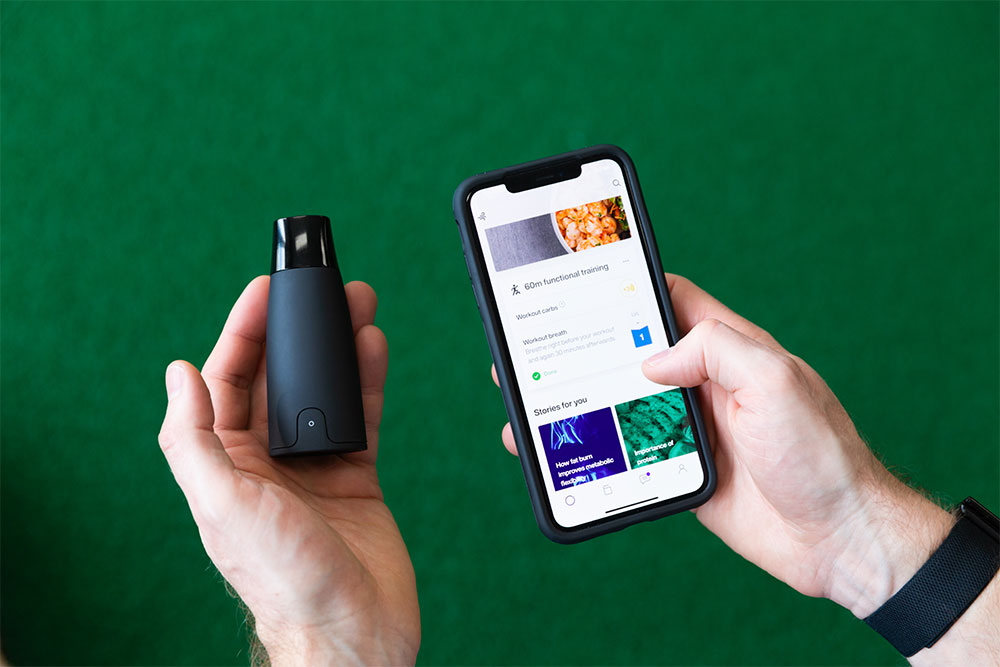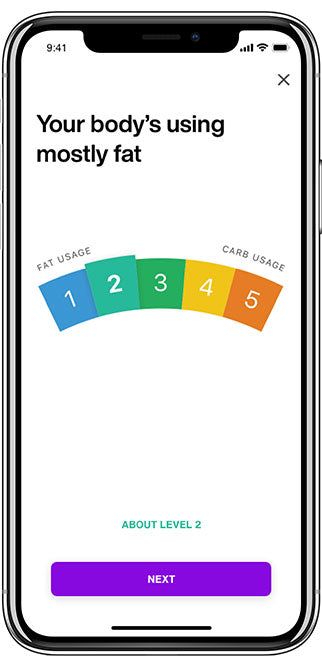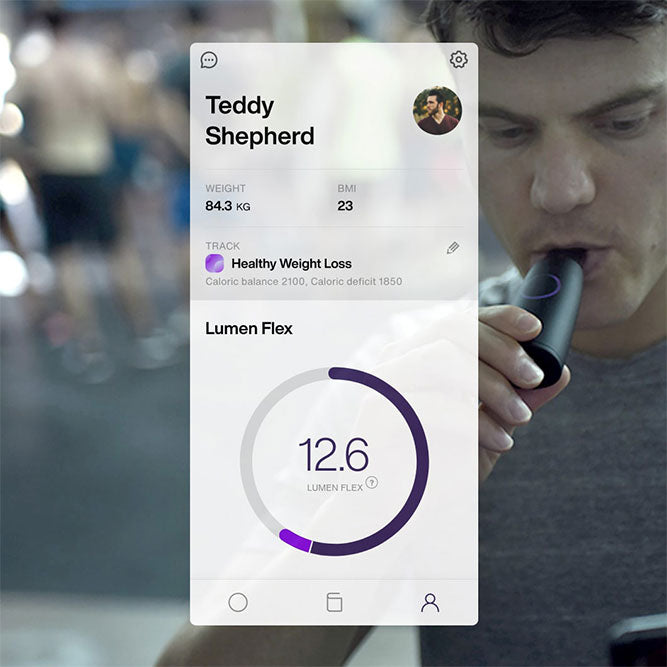How Biohacking My Metabolism Revolutionized the Way I Think About Nutrition

Sponsored by our partner, Lumen.
It’s 7:00 a.m. and before I even roll out of bed, I reach for my Lumen — a brand-new device which pairs with an app on my phone to measure metabolic activity and dish out nutritional guidance to improve body composition. To be honest, it looks like a matte-black chic cross between a vape and a breathalizer.
I inhale through the Lumen for five seconds, hold for 10 seconds, then exhale into the device for five seconds. For a more accurate reading, I repeat twice more, and (to my grumbling stomach’s delight, as I near the end of my 16-hour intermittent fast), it tells me exactly what I hope to see first thing in the morning: I’m in fat burning mode. Boom.
As a curious skeptic, athlete and health-obsessed writer by trade, I’ve watched wellness trends flood the market for over a decade. Some stick around (think: CBD oil and infrared saunas), and others, not so much (think: tea-toxes and appetite suppressant lollipops). I consider myself active and healthy. I’m 31, hardly drink booze, and workout at least five times per week. I’m 5’ 3’’ and 110 lbs, so weight loss isn't an issue as much as weight maintenance. My main goal? To ensure my nutritional intake maximizes my body’s potential. While I’m no pro athlete, or RD, I’ve always been interested in sustenance. I don’t count micros or macros — well, until now, that is — but I’ve always paid attention to how food affects how I feel, sustains my training goals, and supports my recovery process.
How It Works (Hint: It’s Easier Than You Think)

When I heard about Lumen, and its promise to optimize metabolism, I was 100% intrigued. I decided to give it a whirl for a few weeks. Here’s how it works, in a nutshell. Each time you breathe into the device, it analyzes your breath and gives you a score on a scale of 1-5. The scale indicates if your body is currently running on fat (1 or 2), carbohydrates (4 or 5), or a mix of both (3). It follows up with nutritional suggestions, tailored to the metrics, of how many carb, fat and protein servings to eat that day to improve your metabolic flexibility (more on that in a second).

But first, to actually understand how Lumen utilizes the breath to ascertain these measurements, it’s important to know the science behind it. Typically, metabolic measurements happen in a lab. Mostly, it’s pro athletes and people with severe health issues, like diabetes and obesity, who get measured. They then score some face time with a doc to discuss optimizing performance, or improving health status. The rest of us mid-range athletes and lay-people will never see these numbers and don’t have a clue about what’s actually happening in our bodies when we eat/burn calories. Getting metabolic metrics is not something people do frequently, let alone daily. Until Lumen.
How Breath Shows What Kind of Fuel You’re Burning
The breath contains a wealth of information about how you process fuel. If you were to hit a lab, as part of your report, you’d get back your Respiratory Exchange Ratio (RER): the amount of CO2 in your exhale (generated during the metabolic process), divided by the amount of oxygen you inhale. A lower RER indicates you’re running on fat, higher means you’re burning carbs.
RER itself was cake to understand. And a recent study by San Francisco State University indicates Lumen can indeed provide comparable measurements to a lab test. But, still skeptical (how can you really distill what’s done in a lab, in a single device that costs less than half of a smartphone?), I checked in with Marley Oldham Carnes, MS, RDN, CSCS, to make sense of it. She says there are strict protocols to obtain accurate lab results. Specifically, it’s important to be in a fasted (~4 hours), rested (no prior exercise) and relaxed (seated/reclined) state, and avoid stimulants like alcohol and caffeine. Lumen, she affirms, is similar — if you use it right.
It’s important to note with a lab test, it’s likely a one-time thing. With a Lumen, you use it daily and throughout the day, if you want. Once you calibrate it on day one via five sets of breaths at specific times (pre/post meals, exercise and fasts), it’s good to go. Your job is to stay on top of inputting accurate exercise data and following the carb/fat/protein servings for best results according to your goals. Lumen lets you know if you’re off track by recommending low/high carb days, according to your body’s needs.
In fact, it may take metabolic testing one step further than a lab can — at least when it comes to personalized in-your-pocket nutritional data… and translation of that information to hone body awareness, performance and composition.
“Planning and timing of high carb/low carb meals and snacks can be a great strategy to help athletes get more from their workouts by fueling and recovering optimally for each workout, as well as help reduce, or increase, the need for different macronutrients based on higher-load days, compared to rest or recovery days,” says Oldham Carnes.
A.k.a it’s ideal for athletes like me, who take training and racing seriously, but may never win a Spartan age bracket.
“One consideration that is unique about [Lumen] compared to more standard forms of metabolic testing is that this device is “calibrated” to the individual using the device and that measurements are continuously taken throughout the day,” she says. “If the device is giving accurate results, then the theory is that this could lead to self realization of how the body’s metabolism changes throughout the day, and in response to various foods and activities.”
So, What Is Metabolic Flexibility?
By giving real-time feedback, Lumen brings the opportunity to improve metabolic flexibility into play: what myself, and most dedicated athletes, care about.

Metabolic flexibility is the body’s ability to switch back and forth between burning fat and carbs as a source of energy, based on availability, according to Lumen co-founder Michal Mor. The benefits of boosting metabolic flexibility by manipulating macronutrients, workouts and fasting? You’ll develop more stable blood glucose levels for consistent energy throughout the day, improve insulin sensitivity to better burn fat, support your immune system and sleep efforts, and may even dodge chronic-health issues like heart disease, obesity and diabetes.
Metabolism is a fluid, dynamic, chemical process. It’s not constant and can change dramatically throughout the day based on rest, fuel, exercise, hormone levels, genetics and more. Ultimately, to achieve your goals, it’s all about carb-to-fat-to-protein intake. Carbs aren’t bad, fat isn't bad. Diets aren’t bad, per se — if they work for you. But what’s really crucial is understanding what your body needs to make gains in the direction you want to go.
“Carbohydrate intake should be individualized based on goals, sport/activity, and how that athlete responds to various macronutrient ratios in their diet,” says Oldham Carnes. “Our bodies use sugar (glucose) broken down from our food as its primary energy source, however our body can use ketones from fat for energy when carbs/sugar/glucose are no longer available.”
In other words, dialing in your metabolism and nutritional program is a personal, delicate dance that evolves as you age and as your performance improves. There’s no “best” diet. Only what works for you. Sounds complicated, and it is. The good news? Lumen’s data may be able to help you figure it out.
Where Did Lumen Come From?
In 2011, Michal Mor and her twin sister Merav were training for an Ironman. They were researching nutrition to optimize and improve their athletic performance. While there were dozens of studies on how fuel can be optimized for endurance athletes, there was no concrete way (save lab testing) to indicate if what they were eating was working for their bodies, specifically.
Frustrated by the massive void between technological advancements and scientific research supporting the importance of macro manipulation in endurance training, they teamed up with three other entrepreneurs to found Lumen in 2014. “We had a clear mission: close the gap between the science world and the consumer world by bringing the technology that's already in use in science, to the day-to-day life of the user,” says Mor. “We wanted to empower [athletes] to make smarter decisions about their nutrition and lifestyle.”
My Takeaways
1. The Feedback is FIRE. Counting Macros is Easier Than I Thought… And Totally Worth It
Lumen is a full-send way to brush up your nutritional knowledge and better strategize around your personal intake — essential to optimize performance and recovery. If you want to get serious about fuel to support your training and racing benchmarks, it’s a solid tool to glean feedback and regulate your macros right at home, in just a few breaths.
Some of my data I could predict. (i.e. I love the occasional late-night popcorn, so mornings afterward, I’d be in carb-burning mode. I’d then know how to adjust my day to include a heavier workout, longer fast, less carbs and more healthy fats and protein to recover well and stay on track with my weight maintenance goal).
Other feedback helped immensely, and came as a surprise. Particularly, when it came to sleep. My shut-eye habits tend to be all over the place. I know sleep hygiene is crucial, but didn’t know just how much it affects my metabolism. (i.e. Just because I’m not gaining weight from a crummy sleep schedule doesn’t mean doesn’t mean I’m firing on all cylinders, either.) As a night owl, I started noticing that when I went to bed earlier (10 or 11 PM, instead of midnight or beyond) and woke up earlier (6:30 or 7 AM, instead of 8 AM), my metabolic flexibility improved. My energy levels were also higher throughout the day, as opposed to when I slept the same number of hours but later in the night.
2. It’s For Me — But If You’re a Newbie, Consider Consulting a Dietician to Help You Understand Your Metrics
I’m still using the device daily, and plan to continue. As I snag more data, I develop better overall body awareness and become smarter about the food choices I make. Before, I didn’t count macros — I just ate healthy and worked out. Now, I’m dialed into what my specific body composition needs, daily. I eat my late-night popcorn earlier and commit to my fast earlier. Since I’m often in fat-burning mode, I’ve also increased the amount of healthy fats and protein in my diet so I’m not losing weight, but rather getting sustainable energy I need to stay stable and get stronger.
That said, what works for me may not work for you. If in doubt, seek a professional before you go nuts on making BIG changes. Oldham Carnes says the device “looks like a lot of fun” and could help athletes learn how their body’s burn fuel, developing self awareness and brushing up overall eating patterns. But, she also warns without additional RD support, it may just be a spendy piece of gear if you don’t know what you’re doing.
“Lumen could help lead to behavior change and reaching health goals, or could just leave a dent in the wallet,” she says. “Navigating this landscape of such individualised nutrition can be complex. A registered dietitian can help simplify metabolic testing results and further individualize nutrition plans that are realistic, and will help create or change behavioral habits (which are key!) to making sustainable lifestyle choices and meeting goals — not just temporarily but for the long term.”
Ultimately, it’s up to how you use Lumen’s data and recommendations to impact your eating behaviors and optimize your performance. But, there’s no doubt about it: there’s a lot of performance-optimization potential for intelligent athletes who want to incorporate Lumen into their training and nutrition programs.
I’m not alone in my takeaways from Lumen. Some of our top athletes at Spartan have been also using it as a body hacking tool. Spartan is currently conducting a case study with some of our leading athletes to examine performance optimization with Lumen, the results of which should be released next month. One of our spartan athletes, Amber Klein, has already seen progress and has been documenting her experience on Instagram.
BONUS TIP: Stay In Service
My only gripe? You can’t use Lumen when your phone is out of service. I bagged a 75-mile, five-day canoe backpacking trip through northern Minnesota’s Boundary Waters Canoe Area. We paddled and portaged for at least seven hours per day and ate a minimum of 3,500 calories per day to stay fueled up. At that point, I had already been enjoying Lumen’s regular feedback for a few weeks, so on the trip, I was dying to know how my body was burning fuel under those unusual wilderness-style circumstances. But hey, nothing’s ever perfect.











